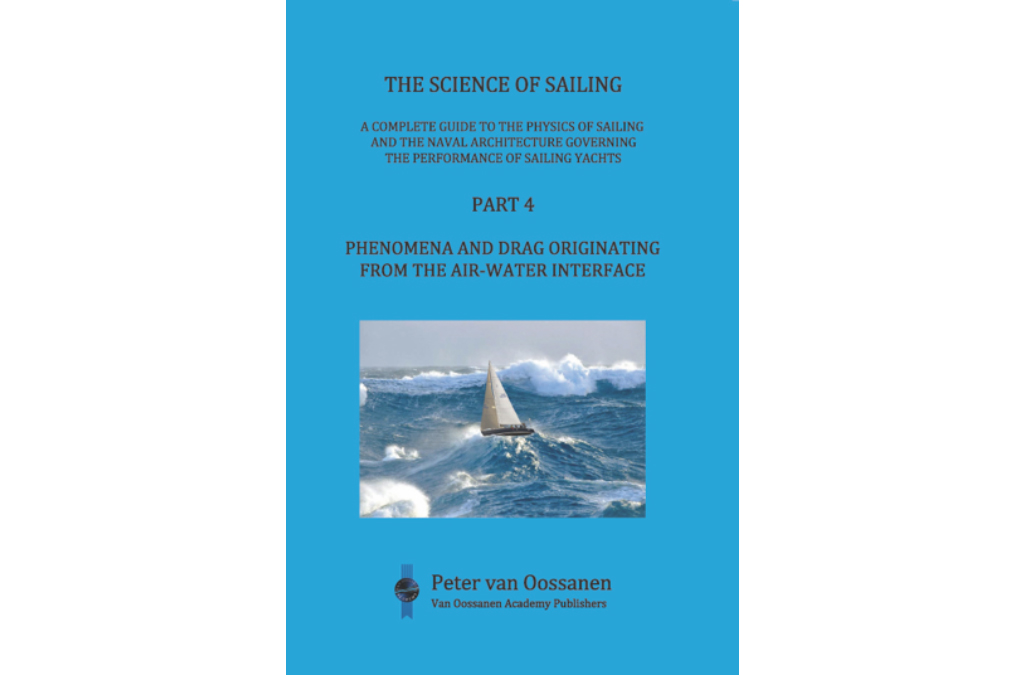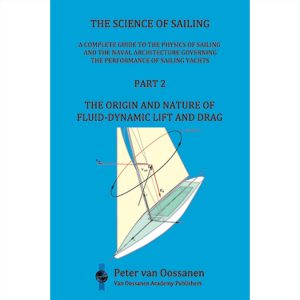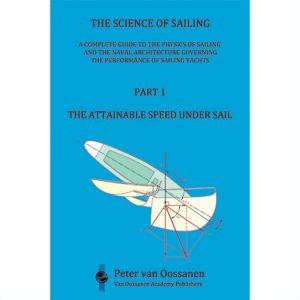Description
The Science of Sailing Part 4
Part 4 consists of two chapters. Chapter 8 is devoted to the phenomena and drag originating from the air-water interface, with little reference to water depth. This lack of differentiation with respect to water depth is permissible for many of the topics addressed – but not for all. The necessary different treatment of relevant subjects in water of restricted depth has been collected and transferred to Chapter 9. Chapter 9 may therefore be considered as a dedicated chapter to the topics of Chapter 8 that need special treatment when the effect of water depth is considered.
Chapter 8 commences with a description, in Section 8.2, of the process by which surface waves are formed by a body progressing at some speed at the air-water interface, and the consequences of such waves on the drag of that body. The example of a submarine-like body, rising to the surface from a depth at which no surface waves are formed, is utilized to pin-point features of the wave-generation process that would otherwise not be distinguishable. Section 8.3 is dedicated to the derivation of the properties of regular surface waves in deep water, with particular reference to the orbital flow in those waves, and the concepts of dispersion, wave energy, wave flux, and group velocity. The derivation of the wave pattern generated by a body travelling at a fixed speed on the water surface is realized by means of a mathematical model that is based on replacing the hull by a pressure disturbance acting at a point. Two such derivations are described in Section 8.4. The first of these is based on a particular geometric property of the generated waves, and the second is based on the theory of stationary phase. This latter method can be considered to be a first principles approach, not needing one or more geometric wave properties for its foundation. Both methods are seen to lead to the well-known Kelvin wave pattern.
The basis laid out in Sections 8.2 through 8.4 is sufficient to begin addressing the important subject of wave drag – the most important component of drag in the case of sailing craft. Section 8.5 commences with a formal definition of wave drag and how this component of total drag can be determined adopting a methodology based on CFD. The energy flux of the transverse wave system is then adopted to derive an expression for the wave drag of the hull that generated that wave system. The pressure drag of the series of sailing yachts that has prominently featured in Part 3 is then presented and the wave drag extracted. The resulting wave drag curve is employed to derive an expression for the average height of the Kelvin wave pattern.
The interference of the wave systems separately generated by the bow and the stern of the hull is addressed in Section 8.6 by modelling each of these wave systems by singular pressure points – one located at the bow and one in the proximity of the stern. This leads to a quantification of what naval architects call “humps” and “hollows” in the (wave) drag curve. The interference patterns of both the transverse- and the divergent wave systems, of both the bow and the stern, are derived as a function of Froude number.
The extensive use of the Kelvin wave pattern resulting from a model adopting pressure points at the bow and at the stern, requires that its accuracy is examined. The comparison with the results of CFD calculations, in Section 8.7, leads to a satisfactory result and a “surprise” with respect to a feature exhibited by the Kelvin pattern that is not so obvious from CFD results. The effects on drag of running trim and sinkage/rise of sailing yacht hulls, as exemplified by the CFD results for the series of sailing yacht hulls considered earlier, are described in Section 8.8.
The subject of breaking waves is treated in Section 8.9 in terms of their nature and the differentiation in types, followed by breaking criteria, and the resulting drag when a hull generates breaking waves. The spray thrown up by high-speed hulls and hull appendages is the subject of Section 8.10. The focus here is on its nature and manifestation, its quantification, its effect on drag, and on spray deflection.
Wind-generated waves are dealt with in Section 8.11. To do justice to this important subject significant space has been allotted to an extended description of the methods adopted to describe a confused sea. This requires treatment of such subjects as the wave amplitude energy density spectrum, histograms, the probability of occurring wave heights and periods, Fourier analysis, and the properties of wave spectra. The prediction of wave height and wave period, on the basis of wind strength, wind duration along the fetch, and fetch length, are treated in detail because of the use that is made by naval architects of such prediction methods. The motions exhibited by sailing yachts are extensively described in Section 8.12, and the calculation of the mean wave-added drag in Section 8.13. The surfing behaviour of sailing yachts in following seas is the subject of Section 8.14. The approach to this subject is new, as are the results obtained by the adopted method, particularly with respect to the quantification of the initial speed and driving force for a hull to be “captured” by an overtaking wave.
Cavitation and ventilation are the last two subjects covered in Chapter 8. Both of these topics are described in terms of a description of the fundamental processes involved, a description of the occurring types, their effects, and their suppression.
The two subjects that need separate treatment in the context of the effect of water of restricted depth, are wave generation and wave drag. Chapter 9 is mainly concerned with these two subjects. Sections 9.2 and 9.3 provide an extension of deep water wave theory to include the effects of restricted water depth (including shallow water). Section 9.4 is dedicated to the extension of the method of stationary phase in such water for the purpose of quantifying the changing wave pattern generated by the hull with varying water depth and Froude number. The consequences on wave drag are found to be significant, as shown by the results of a systematic series of CFD calculations, in Section 9.5. The associated wave patterns derived from these CFD calculations are shown, and commented on, in Section 9.6. Finally, the effect of water depth on running trim, sinkage/rise, and squat, are presented in Section 9.7. These results are, likewise, derived from this systematic series of CFD calculations.
Prices exclude 9% value added tax, for orders outside of The Netherlands we do not calculate tax. For shipping and administration cost we calculate €6,95 for The Netherlands and €14,95 outside of The Netherlands.
Attention! If you wish to order from outside the Netherlands OR more than one book please use this form.








